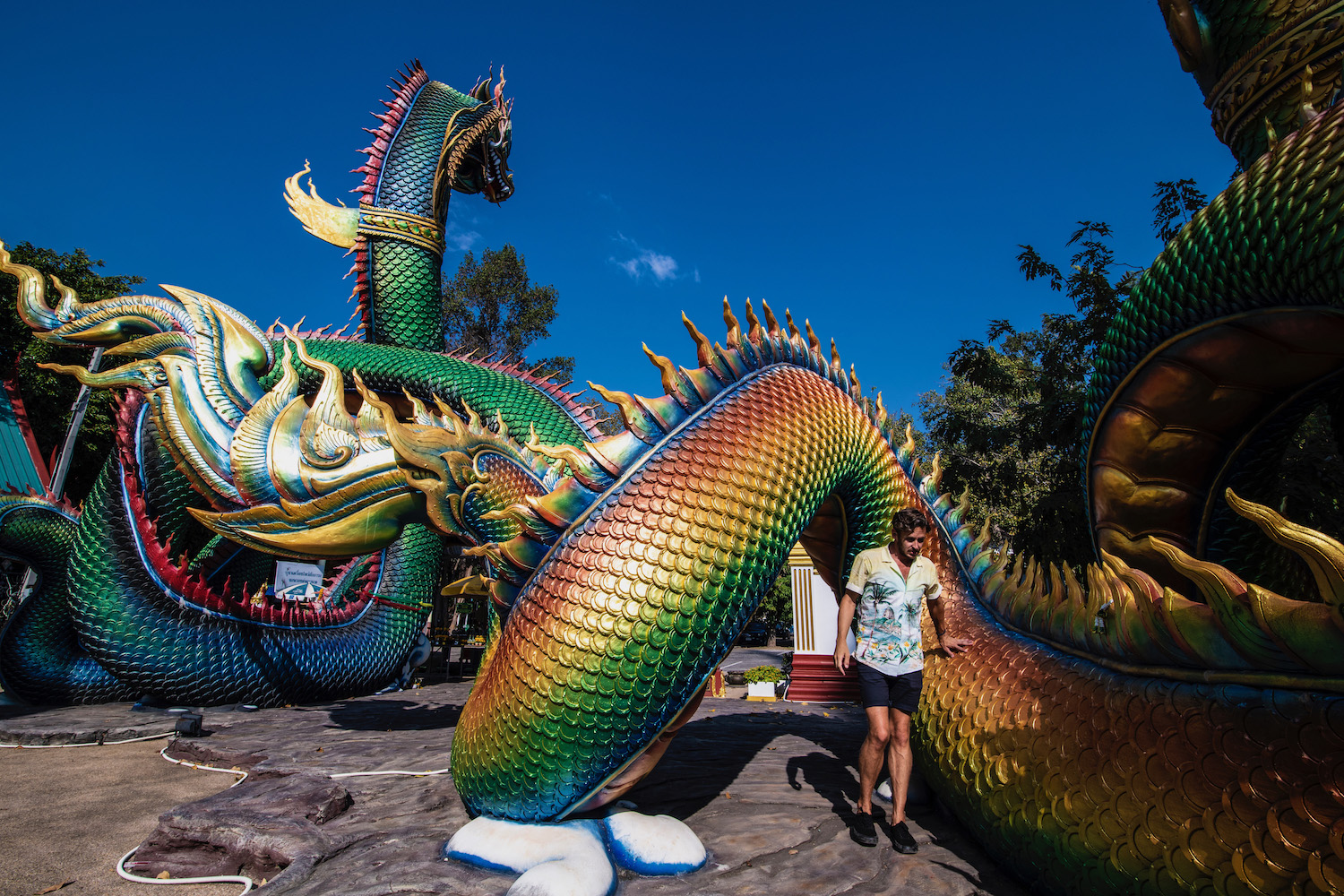That Prus’ mom drove us from their home in Sriracha to Suvarnabhumi Airport is not, on its own, remarkable. Given that I had just stayed a week with the family, who didn’t know I existed prior to the moment we met and may still have only a vague idea of who I am, her offer to chauffeur us was downright saintly.
“She loves you,” Prus reassured me as she drove away.
He grabbed my hand and, with the exception of the security check and aircraft boarding, didn’t let go of it until about two hours later, when we arrived in Udon Thani.
There, as the sun set over the Isaan region, we stood in the airport parking lot inspecting what appeared to be the only remaining rental car in the entire city. Well, Prus was inspecting it; I was making a video of him doing so for posterity.
It was nearly dark by the time we drove off in the decade-old Toyota pickup, which very clearly belonged to a random person who needed to make some extra cash. Yet it was somehow the perfect set of wheels for a road trip through the “Texas of Thailand,” at least assuming none of the motorbikes or tuk-tuks or motorbikes attached to food trucks weaving to and fro along the poorly-paved roads into town ran us off them on our way to the hotel.
I don’t remember precisely when we started holding hands again, but I do remember we were doing so walking back to our hotel from a nearby restaurant that was uncharacteristically attractive, for Isaan, but also didn’t serve any typical Isaan food.
Several of the hookers on the street, which appeared to constitute the red-light district of Udon Thani, tried to lure us into their dens in spite of this.
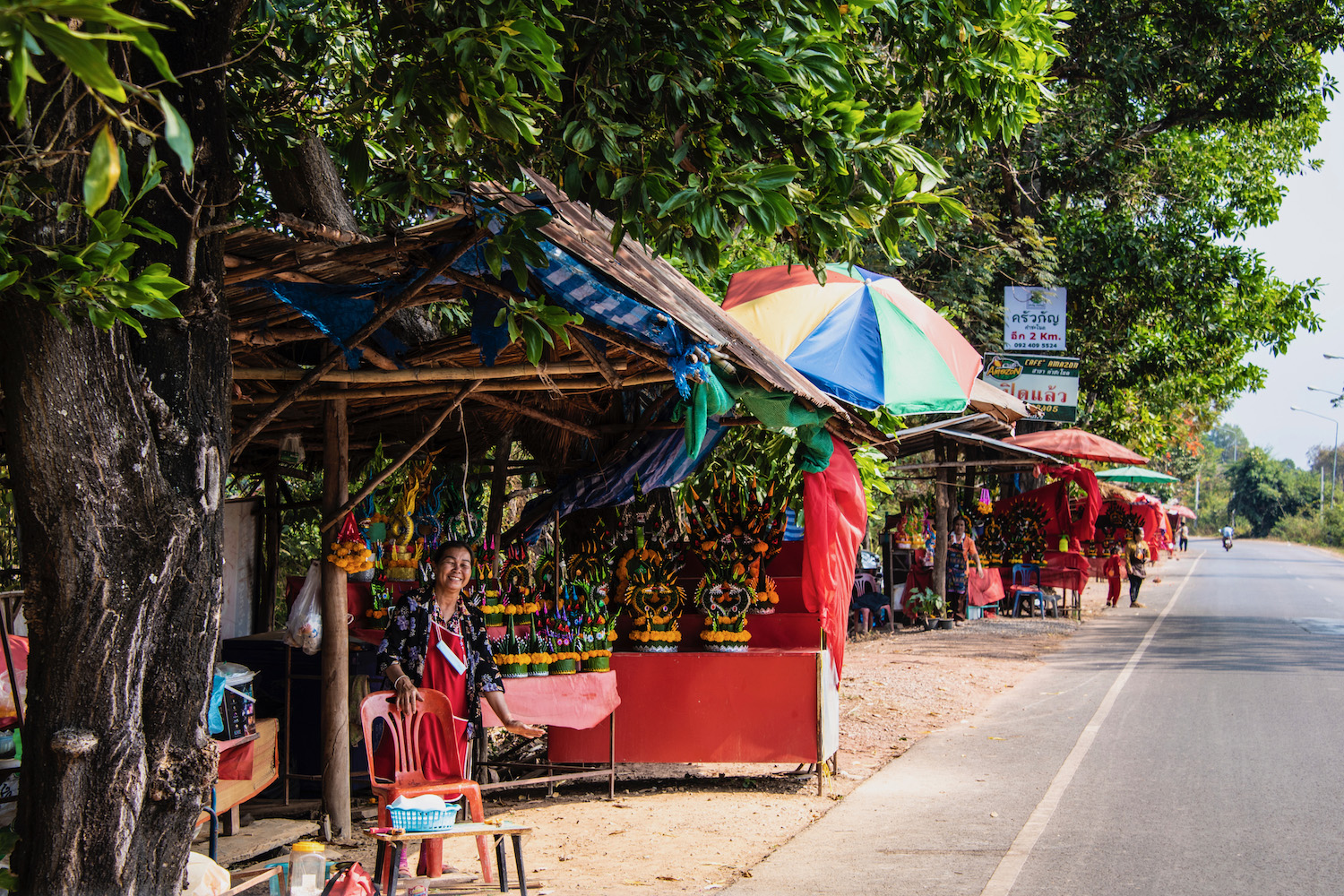
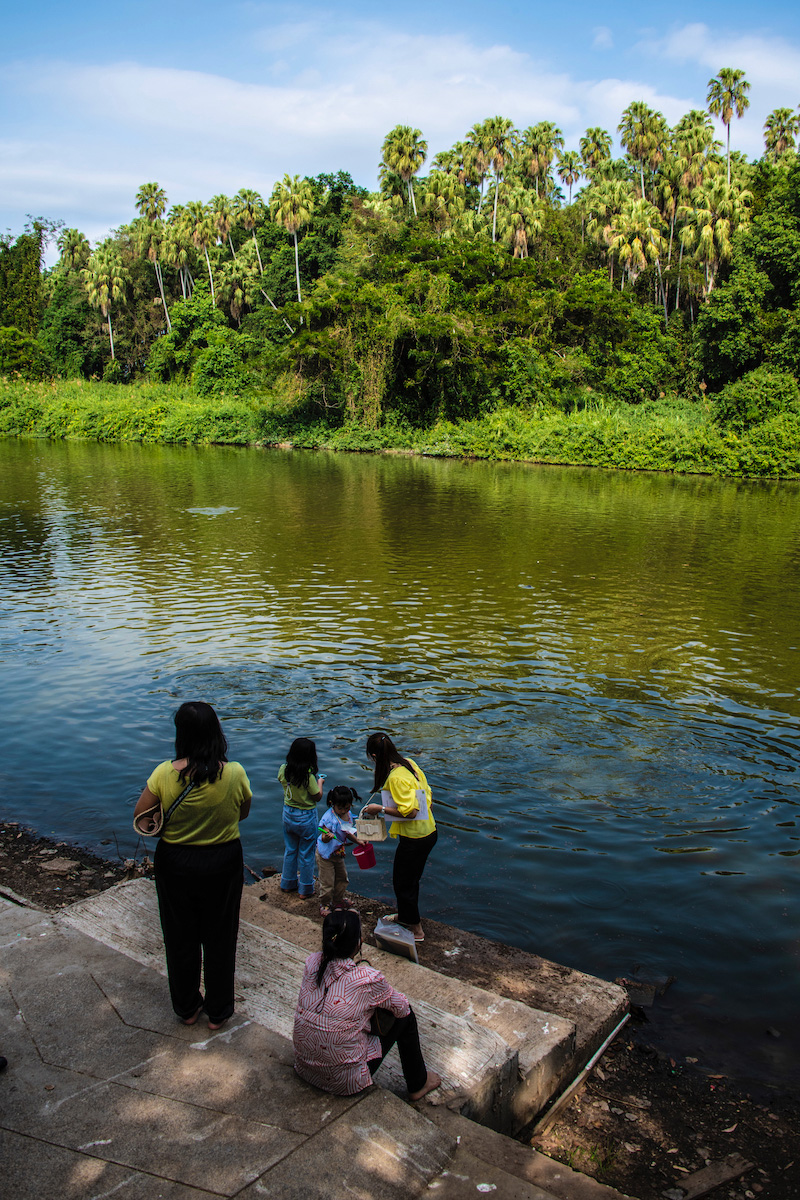
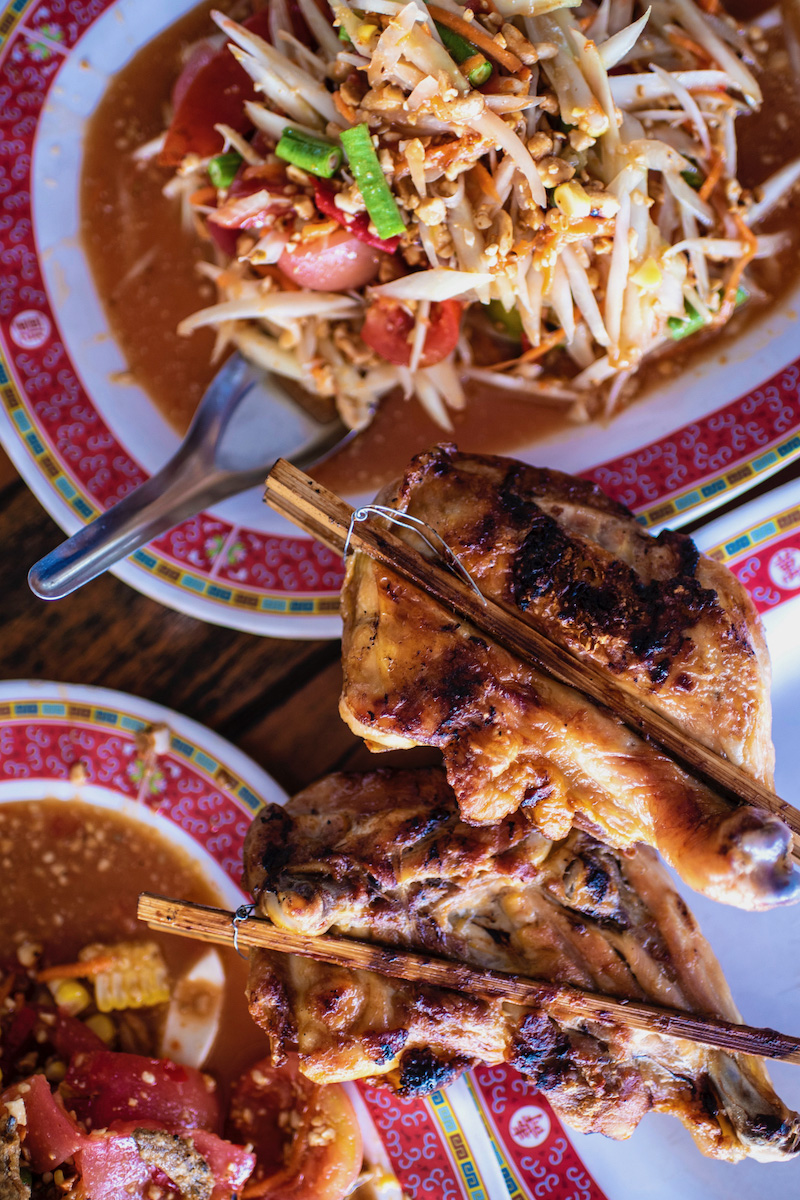
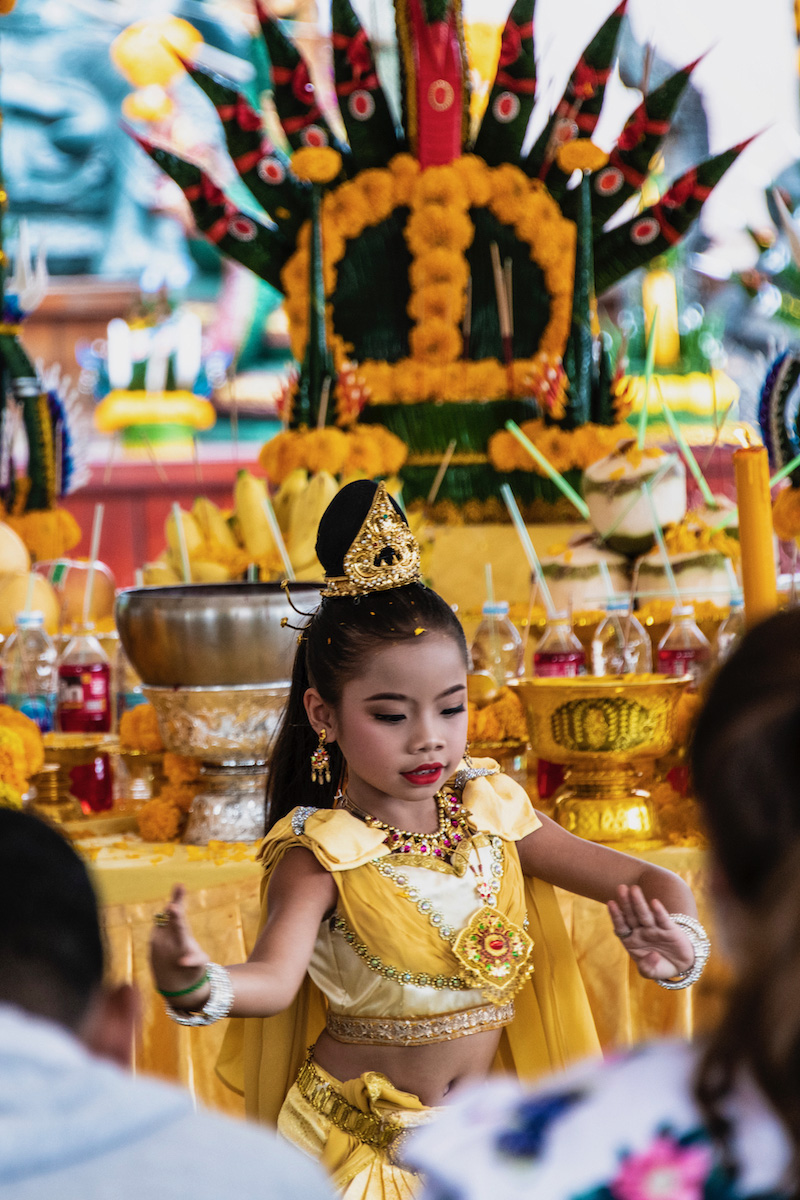
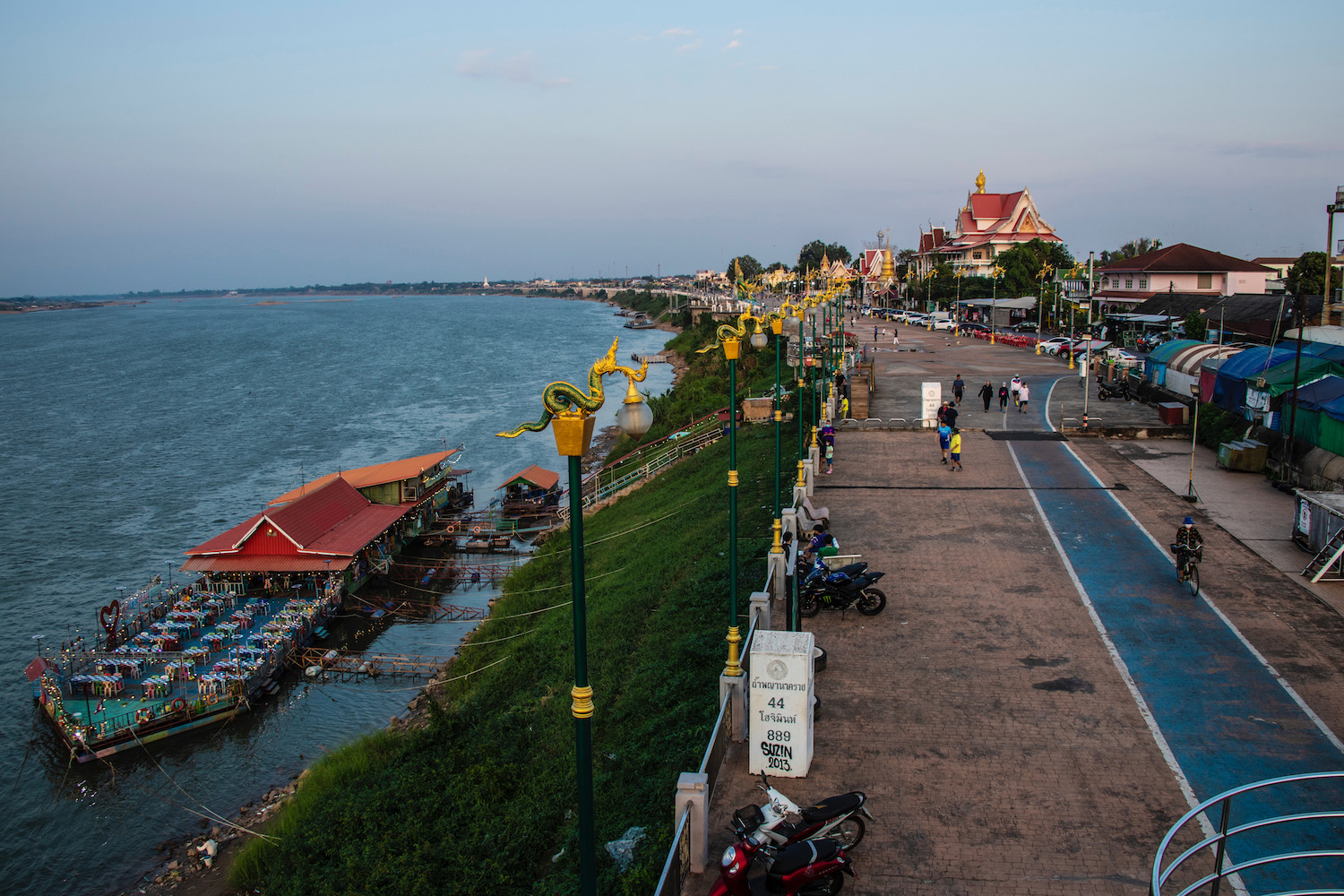
As Prus and I made our way to Udon Thani’s Talee Bua Daeng (aka the Red Lotus Sea) Wednesday morning, seven years to the day after my friend Dora and I had visited, I wondered whether that old saying about all the cells in your body regenerating was true.
The weather was hideous, so we decided to postpone our visit until the next day—this is a place that demands a blue sky. On the drive back to town, during a discussion about possible alternative plans for the day, the number seven came up in an anecdote about a mythical snake.
“The king of the Naga protected Buddha from a storm for seven days and seven nights,” he explained, when I asked why images of the serpent were so ubiquitous throughout Thailand (and especially Isaan).
We would be seeing plenty. After a stop at a popular merit-making sanctuary around lunchtime, we planned to end the day along the Mekong River in Nong Khai, where “fireballs” rise out of the water roughly in the shape of Naga one day per year.
(Spoiler alert: That day is not February 2, at least not in 2022.)
It took about 90 minutes to drive from the city center to Kham Chanot, along the road to which sellers of Naga-inspired grathong offerings attempted to wave faithful Buddhists down by undulating their wrists in a snakelike fashion.
Combined with the fiery blossoms falling off the Flame Trees overhead, and the seeming endlessness of the stalls one after another, their fluid motion gave the entire scene an otherworldly feel, like we had driven into a Thai horror movie. I half-expected an actual ghost to be sitting under one of the yellow sala I saw on either side of the thanon every few hundred meters, but no beings of any sort made use of the shelter they offered.
Or maybe they did. “The Naga exist in another dimension,” he explained without really explaining, as we crossed the serpentine pedestrian bridge to the main shrine of Kham Chanot, which sits on a heavily-forested mangrove island. The stench of the mud that prevents it from sinking into the surrounding swamp was almost as unbearable as the heat was unrelenting.
On the way out, after Prus gave his offering, I noticed a child dancer (she couldn’t have been older than six or seven) performing in full makeup under a tent where no less than two dozen Naga images menacingly stood. She knelt down to pick up a scattering of marigold petals from beneath her feet, tossed them up into the air and resumed her routine, without missing a beat.
On the way to Nong Khai, driving amid shallow lakes (one of which, I think, was the Red Lotus Sea), the subject of the future came up. Prus and I dipped out of the blissful present for what felt like seven years; I have no idea whether, during the course of our discussion about Brazil, Mexico, the distractedness of US immigration officers, Santa Barbara and the Bubba Gump Shrimp Company, whether all the cells in our bodies regenerated.
But in Nong Khai, shaded from the setting sun by a mammoth two-headed Naga statue on the banks of the mighty Mekong, I prayed the seven days and seven nights we were still certain to have together would not be the end of the road for us.
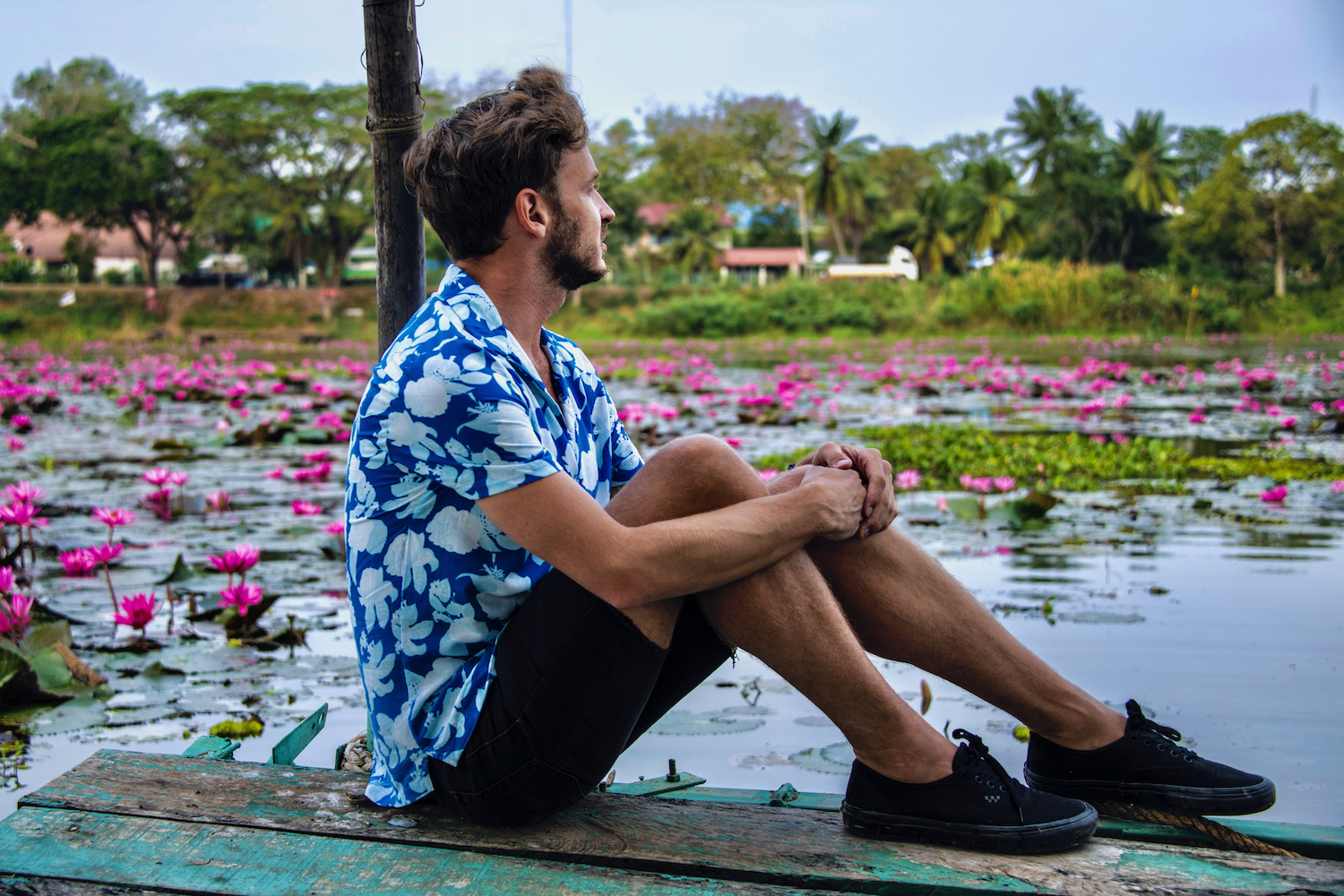
Waking up Thursday morning to continued cloud cover, I made peace with the idea that Prus and I wouldn’t end up seeing the Red Lotus Sea together.
At least not for now. “We can go again when I come back with the nine-headed Naga,” he said, referring to a hypothetical return trip to Kham Chanot to repay the karma of his wish, assuming it ends up being granted.
It spite of this peace, or maybe because of it, countless bua daeng teased us as we drove over the lake’s southern extremity on our way to Roi Et. After having a brief communion with the flowers—and a heart-stopping one: we walked out onto a rusty, barely-still-floating fishing shed in order to see them from water level—we continued on our way, through pastoral backcountry that was bucolic but not breathtaking.
That—the taking of our breath—occurred whenever we tried to overtake another vehicle on the rough road. Especially riveting was whenever a truck piled high with sugar-cane stalks stretching 20 feet in the air was in front of us and we sped around it, barely dodging the half a dozen motorbikes coming the other direction in the right lane before we got back in the left, only to realize that another massive truck was blocking our way and we’d have to do it all again.
Sometimes, between the percussion of the tires traversing the potholes underneath us or the hesitancy of the aging engine trying to pickup speed, I wondered whether we’d make it at all. Periodic clouds of smoke that rose off freshly-burned fields further clouded my certainty, particularly when I realized the accompanying aroma might have another source.
“I think there’s an MSG factory around here,” Prus said once we finally hit an open stretch, and held my hand in his. It was a romantic gesture, but a terrible thought, the manufacturing process of something like monosodium glutamate. What an awful thing to be made!
We made a brief lunch stop in a town whose name I can’t remember, where the only grand thing were the yellow-ribboned arches that rose above its anonymous intersections to pay tribute to the king. While the heat of the chilies in the larb zapped my tastebuds numb, my eyes were free to do their own tasting.
“Have you ever noticed,” I asked Prus, who was taking a bite of sauce-covered gai yang glued to sticky rice, “how pale and pink the tomatoes in som tam are?” Their color matched their flavor, which complimented the rest of the papaya salad like it had been made in a supercomputer, instead of a mortar and pestle.
Continuing along the road, with country-pop bangers and bro-love dirges papering over the organic music of an Isaan road trip, I noticed a slight oddness in the air.
And the earth for that matter: Stands of eucalyptus trees stood everywhere I looked, as if we were in Queensland instead of Kalasin, were it not for how emaciated the cows appeared. Their skin puckered and pulled under the weight of raindrops during a brief downpour that probably shouldn’t have fallen here at this time of year.
When we arrived at Phra Maha Chedi Chai Mongkol, a massive pagoda complex at the eastern extremity of Roi Et province, I wasn’t sure what to think. The magnificence of its ivory and gold seemed all the more resplendent because of how ordinary the landscape it all rose above was. The ornate interior of the main Chedi, which like so many in Thailand is said to enshrine an actual relic from the Lord Buddha (Gautama, I assume), heightened this.
“It’s like a video game temple,” Prus said as his line of vision followed the trippy spiral staircase that led to the top of the spire, just before we climbed it together. I half-expected the Zelda theme song to start playing. Naga, as always, was omnipresent, adorning the banisters on either side.
Even when we got to Roi Et proper, looking down on the its surprisingly handsome (for Isaan, certainly) cityscape from the surprisingly high Roi Et Tower, we could not escape Naga’s presence. The snake physically ensconced a Buddha image to the northwest of the large moat that encircles the tower, precisely in the way Naga itself was said to have protected the Buddha for seven days and seven nights.
It was the same sense of safety I felt after night fell and Prus, unable to find a place in the night market for us to eat our khanom pang sang kaya, put down the bed of the truck like we were two teenagers in the Texas desert.
As we dipped our cubes of green bread into creamy pandan-flavored custard, the lights of the now-illuminated Roi Et Tower flickering down at us, I wondered what I had done to deserve such profound romance, and whether I might to have to go back to Kham Chanot in several years and make my own offering alongside Prus when he makes his.
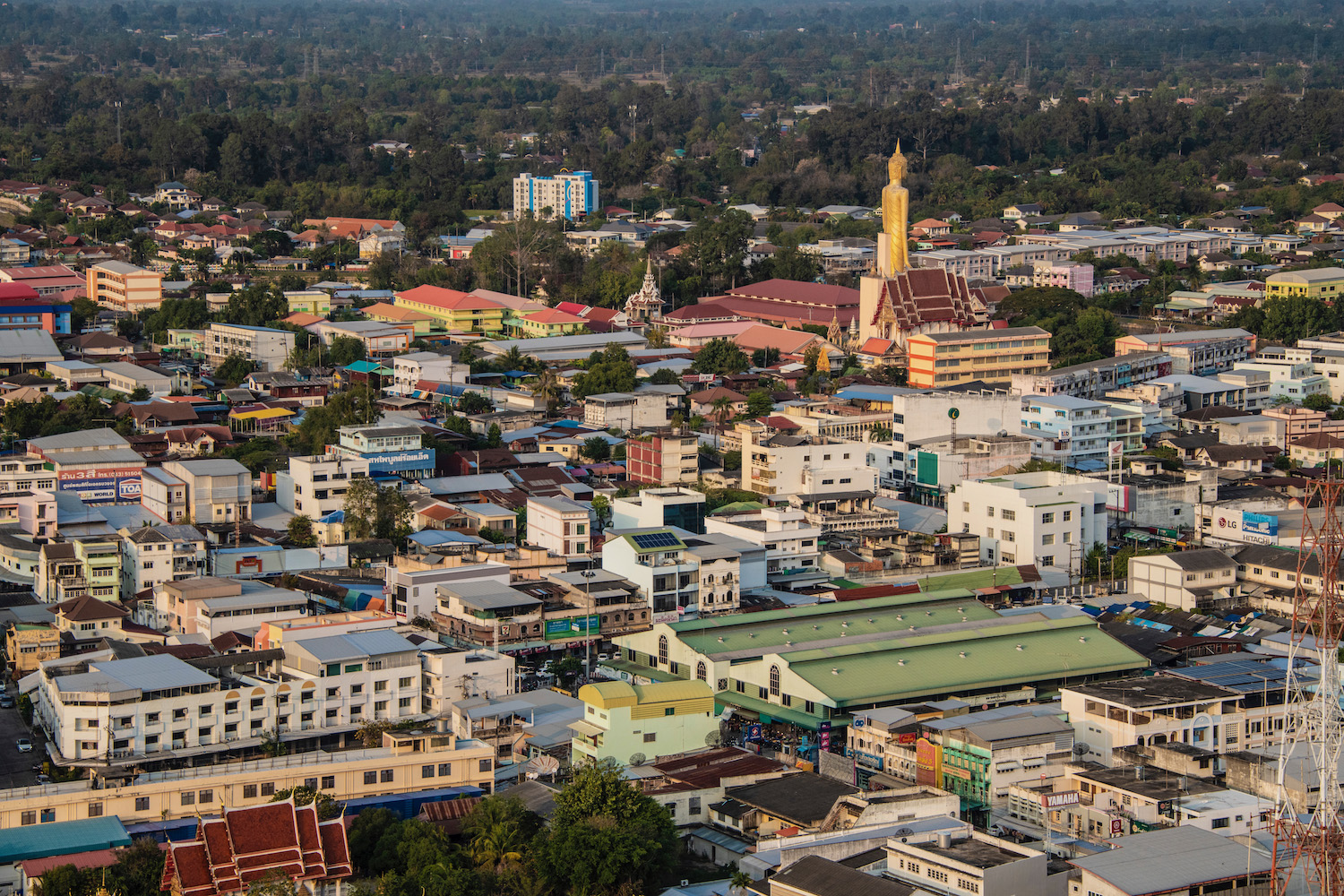
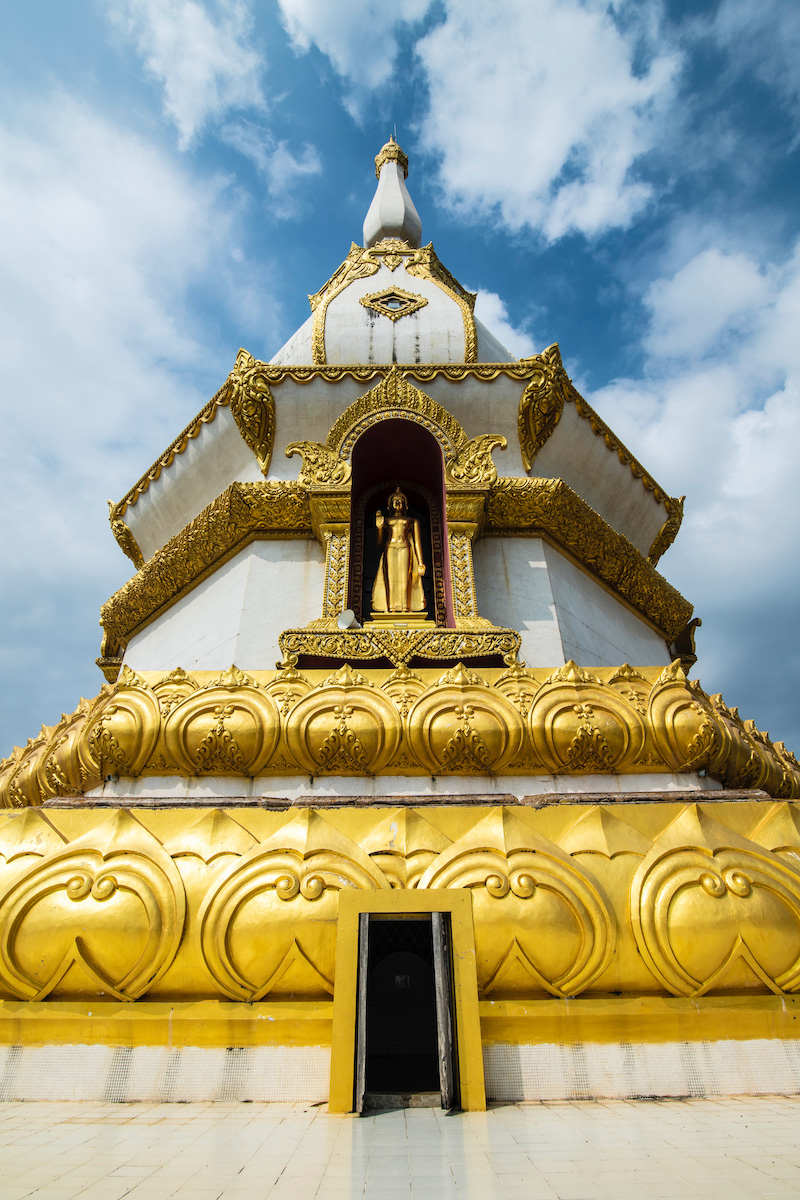
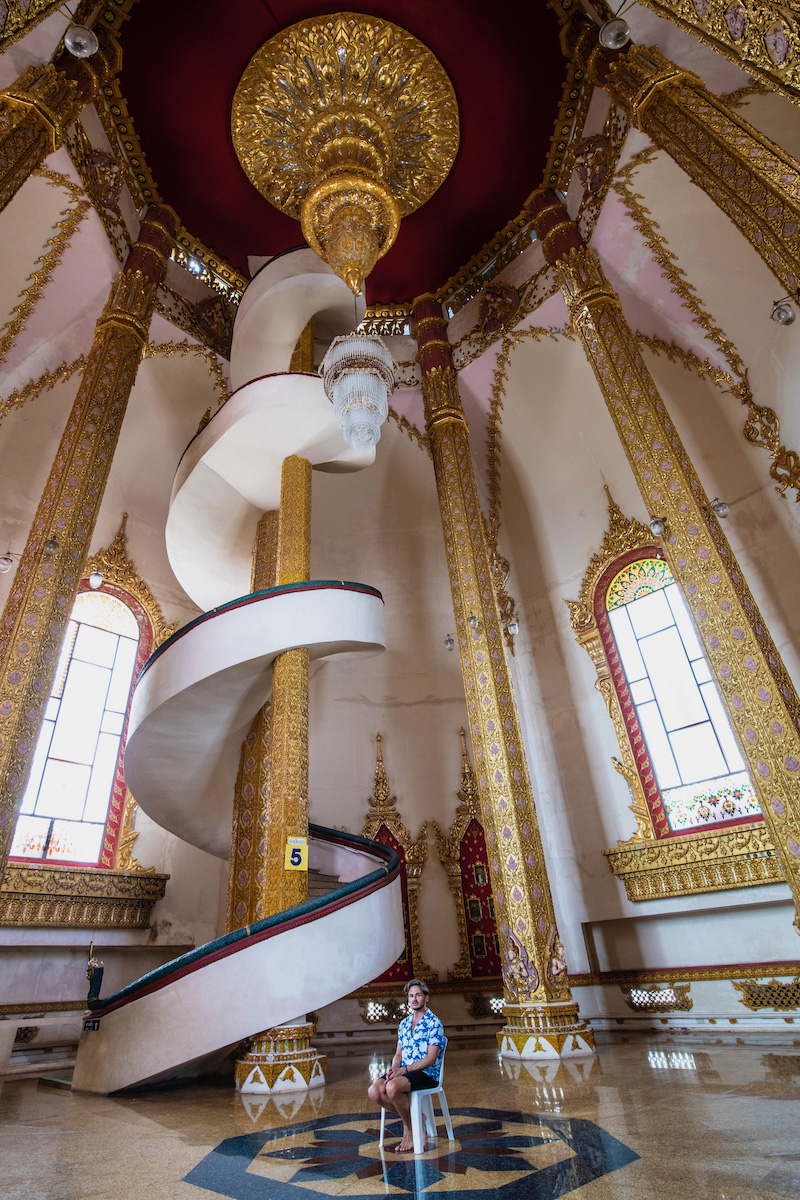
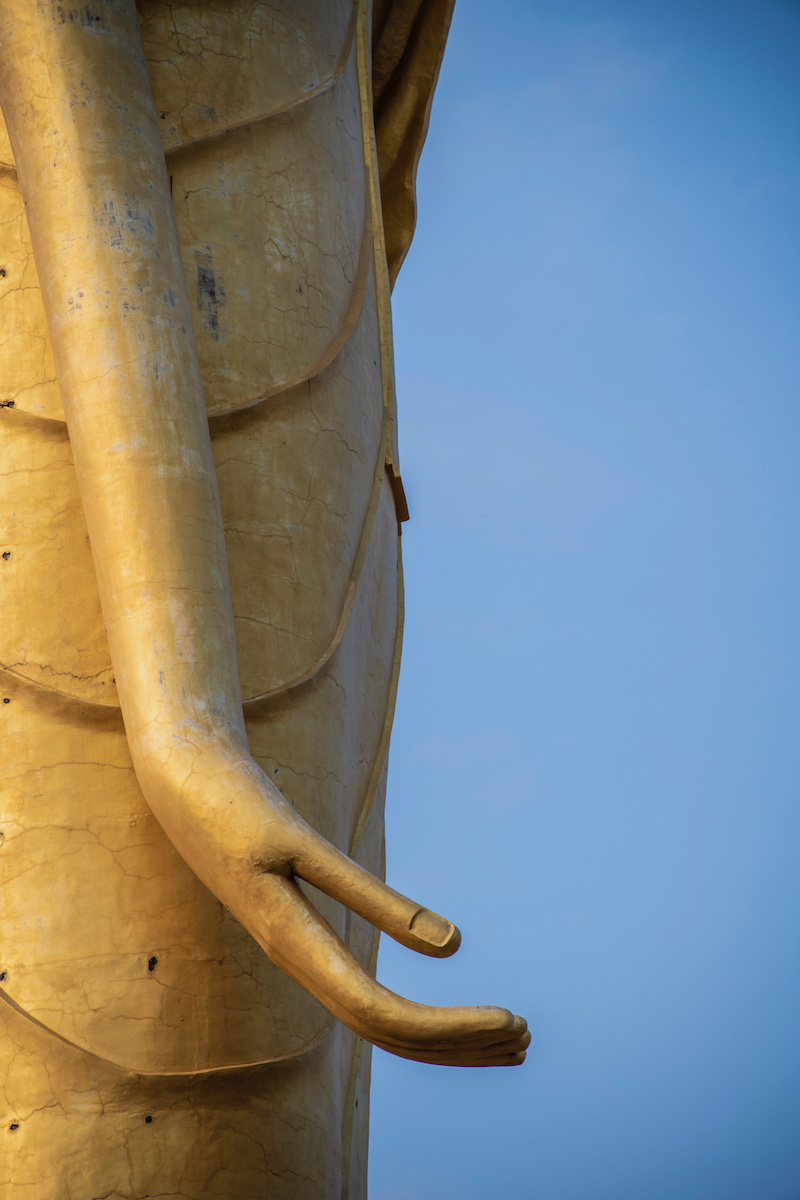
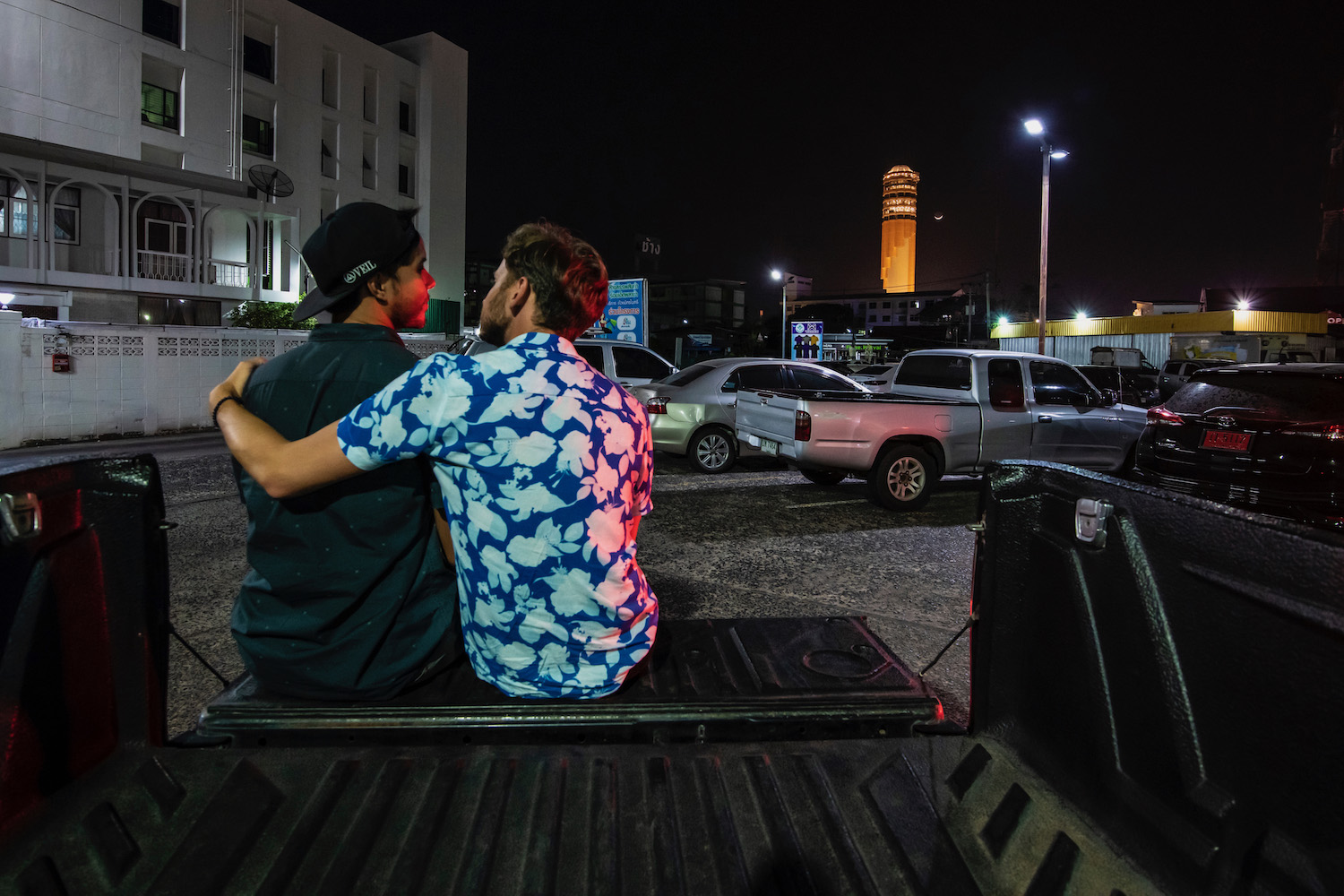
For a small number of miles on the surprisingly wide, smooth road between Roi Et and Ubon Ratchathani, the sala that sprung up every few hundred feet were turquoise instead of their usual mustard yellow color. The rice fields along this stretch were also alive and chartreuse instead of deadened and straw-colored, although I’m unsure if these two facts were related.
With the exception of these details, of course, the nondescript background that sat on either side of Highway 23 could’ve been Missouri, although I’m struggling to think precisely where in the state it reminded me of. I was distracted: Prus, who had downed Thailand’s highly unregulated version (the original version, I’m told) of Red Bull to fight a bout of morning fatigue, assigned me a YouTube video highlighting a Thai-American couple who had started their own Thai street food truck in my former hometown of Austin, Texas.
“She grows her own grapaw!” Prus said excitedly, as the cameraman spotlighted the holy basil plants in the woman’s garden. “I want to grow my own grapaw in America.”
As we entered the home stretch of the road to Ubon, signs of civilization quickly emerged, even as the trees remained the size of mid-rises. I lost count of the number of gai yang stalls that stood on the left side of the highway as the speed limit lowered; the scale of loss to chicken life was absolutely incalculable.
“That’s so creepy,” Prus remarked, referring not to the dead birds but the vehicle passing in the other lane. “An ambulance without sound.”
One thing about Ubon Ratchathani that has remained the same, at least in my mind’s eye, between my first trip and 2017 and now: There’s no defining feature or landmark, let alone a unifying urban center. This was particularly jarring when compared to curated, manicured Roi Et, which might just be the most attractive city in Isaan. Ubon is just…ubon, which means “lotus” in Thai.
The last time I was here, the weather was so oppressively hot I’d spent most of my time indoors. On day one, after biking from my poorly-located hotel along the river down to Wat Thung Sri Muang and back up to Wat Phra That Nong Bua, I hid out in the refrigeration of my room to watch sunset. It—the sunset, this is—had been the color of the juice that’s leftover when you finish eating somtam, although slightly cloudier because the intensity of the A/C fogged the window.
This time, as Prus as I walked out of our rental pickup on the grounds of Wat Phra That Nong Bua together, there was a slight chill in the air, in spite of the bright sunshine. He said he wasn’t sure he wanted to take his shoes off to walk inside the stupa; he was afraid the floor would be cold.
Toward the northeastern end of the grounds the chedi rises above, a pair of twin Naga rose in attack formation. Prus knelt beneath them to make an offering, but became frustrated by the missing numbers among the Kau Chin lottery poetry sticks and gave up. “How can this possibly be accurate?” he packed them back up, in doing so (I assume) abandoning his request.
Next we began our journey to Sam Phan Bok, which had been under the waters of the Mekong the last time I visited. Although its name translates to “three thousand holes,” it’s colloquially known as the Grand Canyon of Thailand.
The nearly-two hour drive was exhilarating, not least because we were literally racing the sun. If we played our cards right (or our Kau Chin, as it were), we’d arrive to enjoy the last 20-30 minutes of the best possible light. I’d get the money shot I’d been waiting more than five years for.
It was exhilarating for me, anyway. I had little more to do than check the clock and our relative position, and stare out the window at the stalls selling fresh pruthra, or Thai jujubes. And to ponder the tattered Thai flags flying above most every one of them: How strange a thing a flag is, how primitive the gesture of flying one!
Prus was clearly still tired; I half-sang over karaoke versions of Katy Perry’s “Teenage Dream” and other mid-2010s pop hits, in hopes my humiliation would keep him awake. (If you’re reading this now, it did.)
As we neared the Sam Phan Bok parking lot, Prus veered off the left shoulder of the road, where yet another eucalyptus stand towered. He had me grab one leaf, which he crushed in his hand and whose released oil he inhaled. I wasn’t sure whether he needed it to further wake up, or simply because he loved the smell, but the smile it put on his face made the question irrelevant.
While we technically arrived before the sun set, a quandary with Google Maps meant that we had to take a 15-minute hike that would’ve been unnecessary had the navigation been clear. The light was all but gone by the time we made it to the first few Bok of the rock formation, which was neither a canyon nor very grand.
“Let’s take a tour next time,” Prus casually remarked as we arrived back to the truck, looking at faded photos advertising said tours, which to be fair weren’t entirely different (and certainly not better) from the ones I’d taken, in spite of the less-than-ideal lighting.
It was anathema—the idea of taking an organized tour, this is—to my philosophy as a travel blogger, but then so was being able to split the burden of disappointment with another person. On the way back to town, I kept Prus awake by lapsing in and then back out of a British accent.
“You sound like Adele,” he laughed, after one particularly contrived monologue. I briefly though about adding one of her songs to my list for future serenades. But they’re all about breaking up; I didn’t want to tempt Naga, given Prus’ previous insouciance.
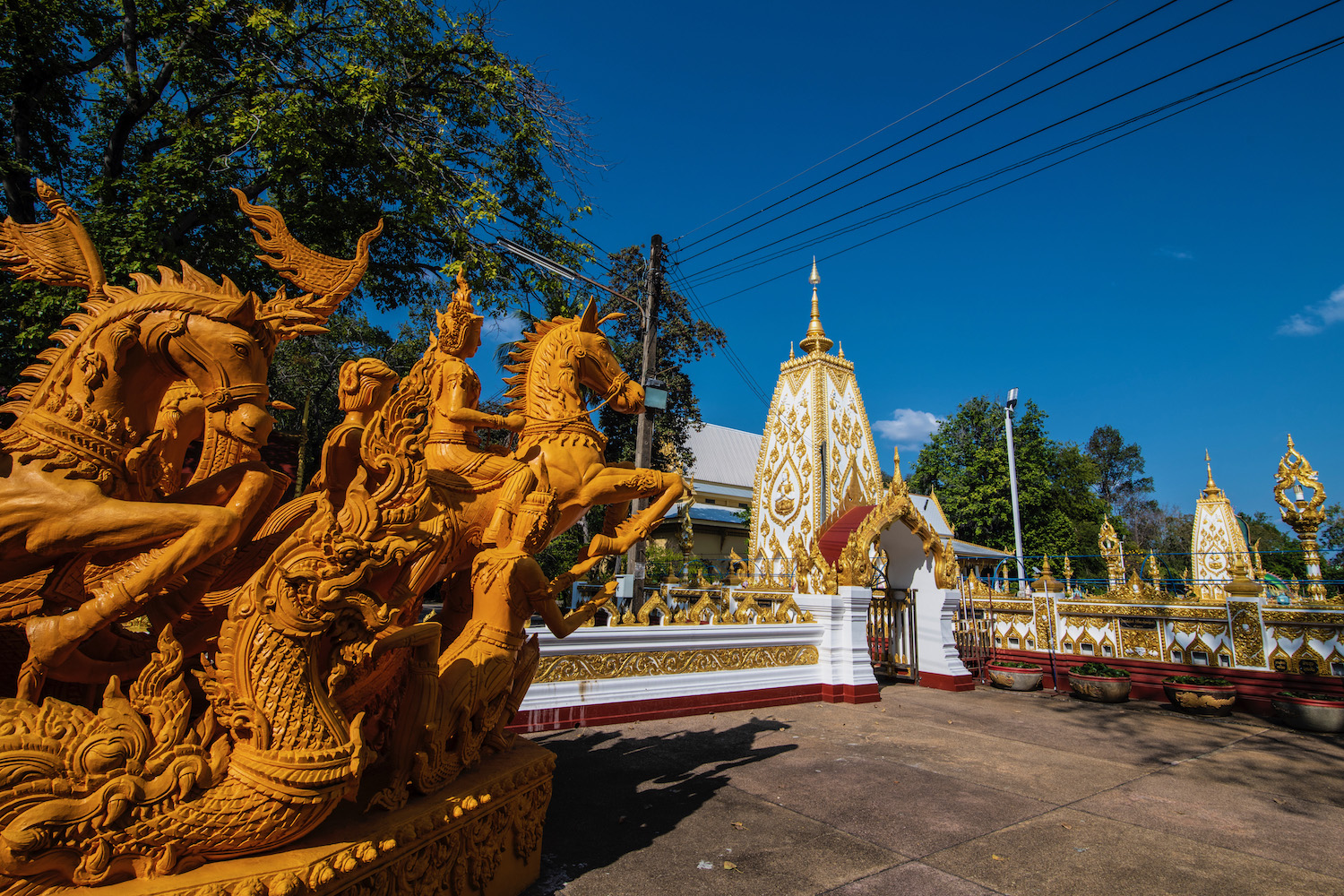
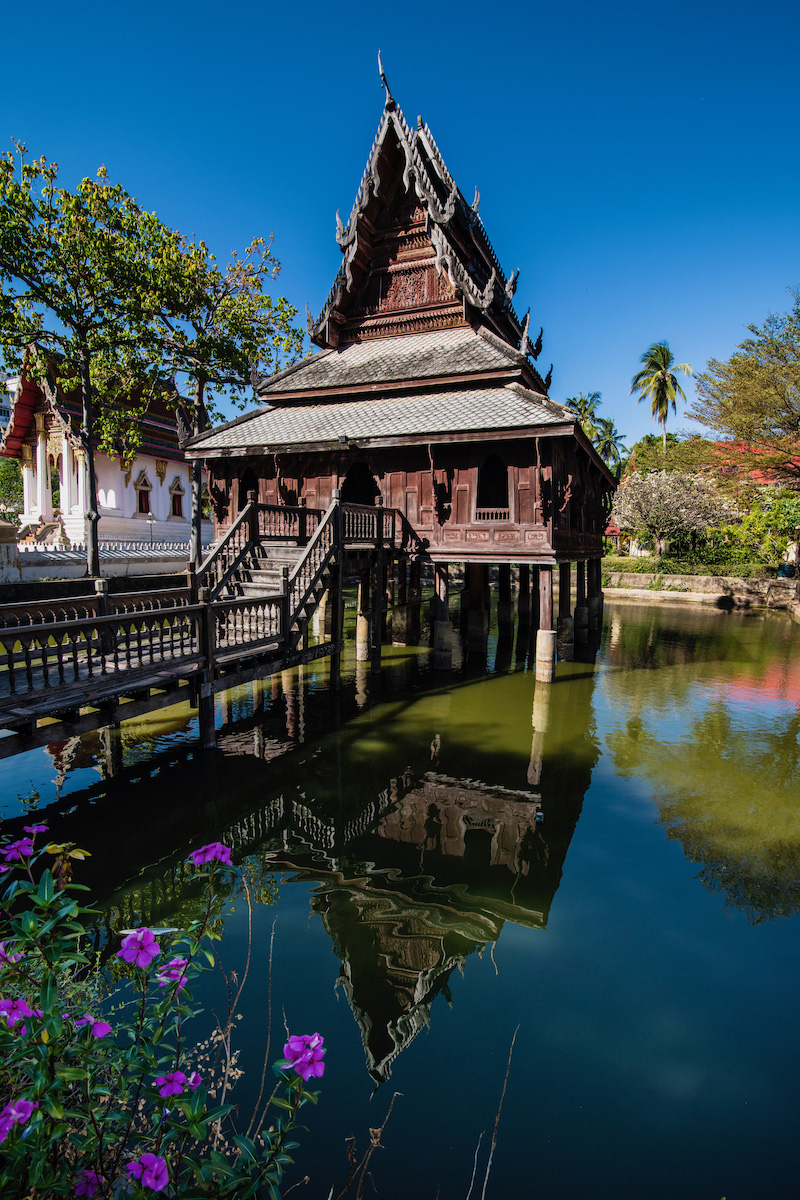
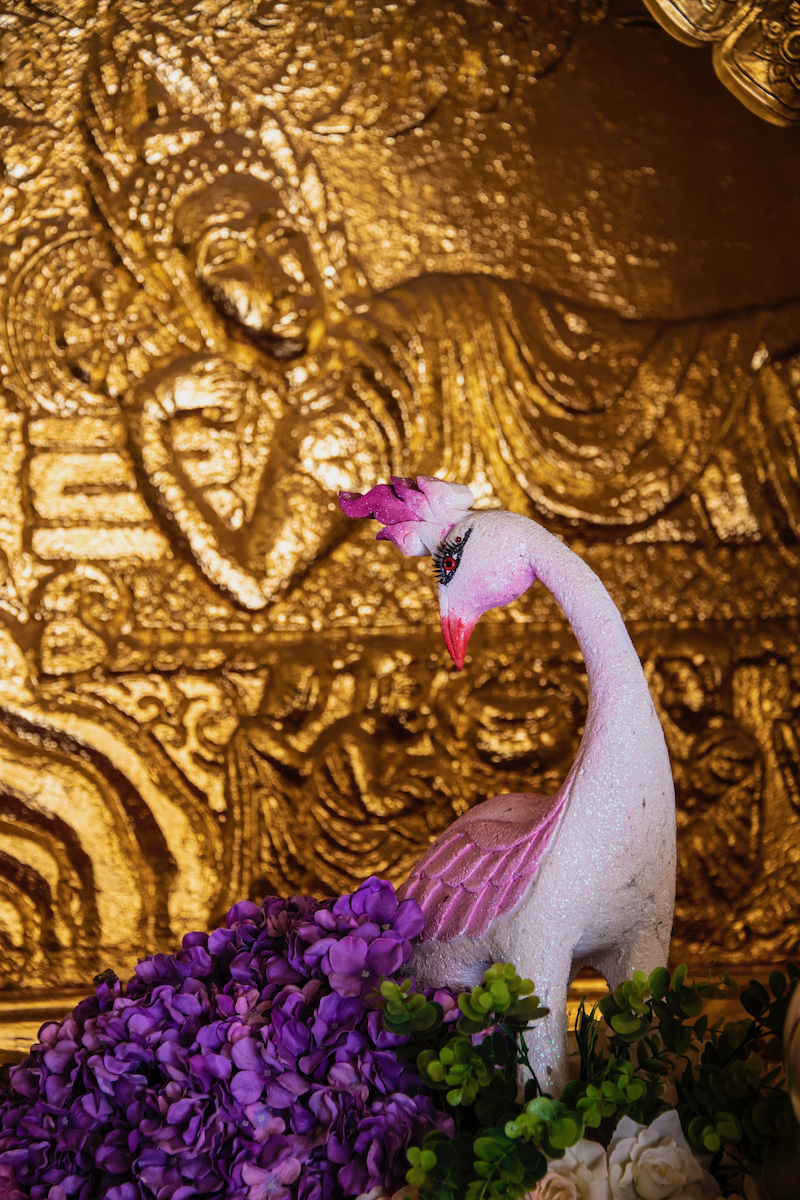
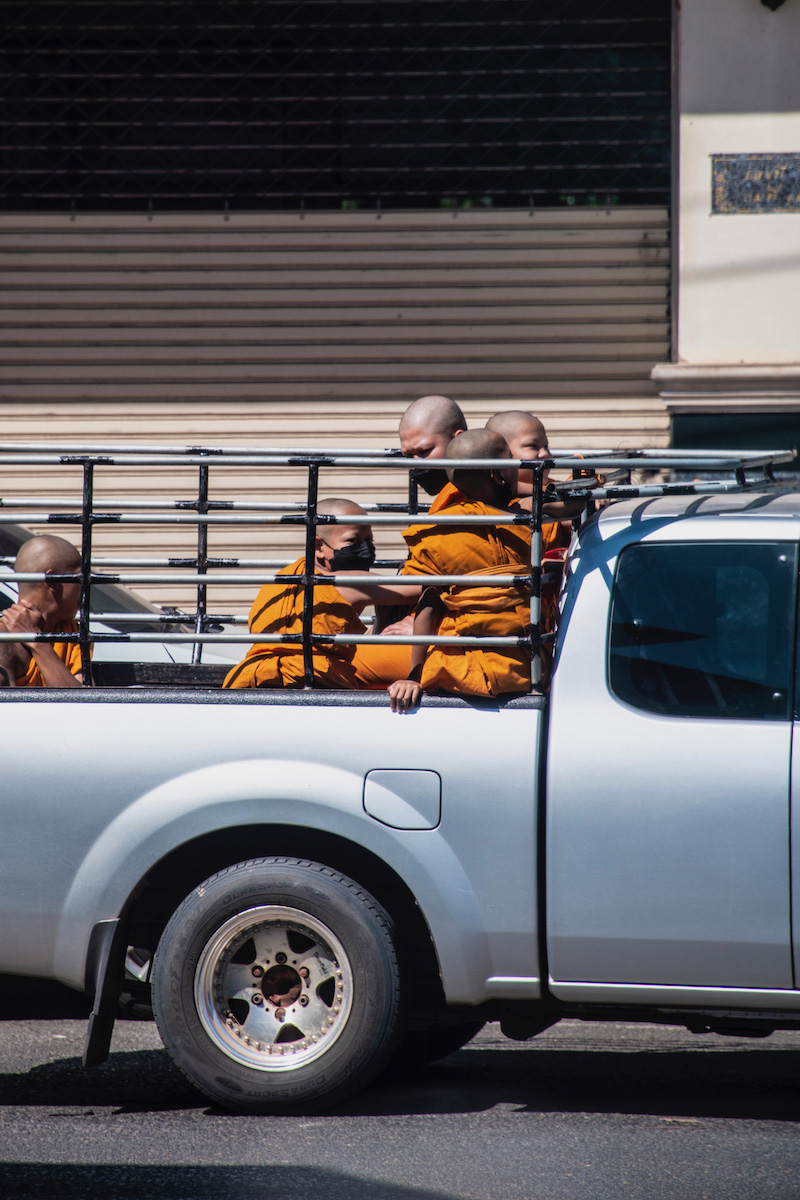
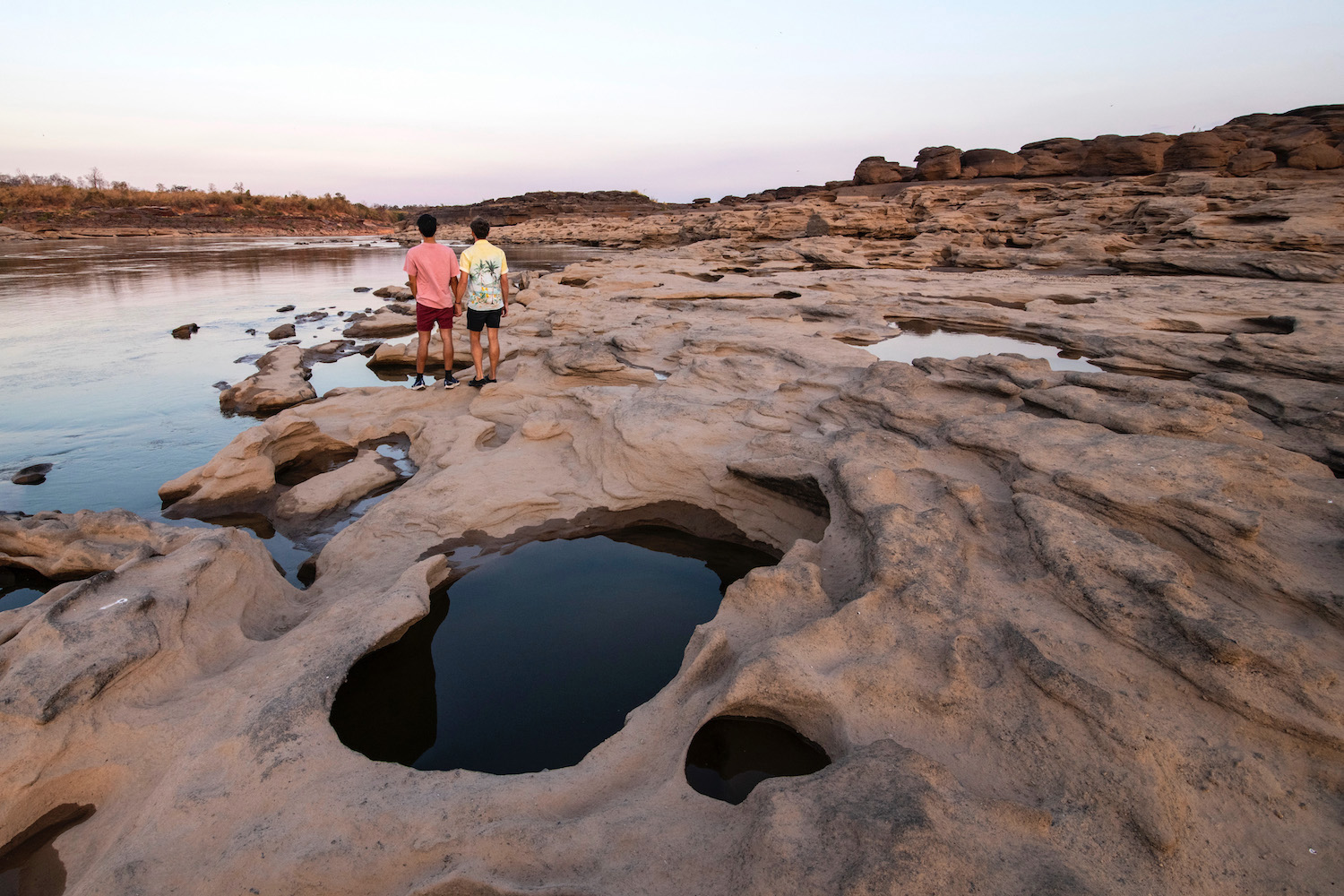
The leaves rustling across the parking lot Saturday morning in Ubon were almost autumnal. I’m getting used to the cold mornings here in Isaan, which is dangerous in a hot country like Thailand.
“Do you remember how we almost didn’t come here?” I asked Prus as we pulled out of the parking lot toward Ubon’s city center for some last-minute sightseeing.
He gave me a side-eye as he made a u-turn. “You mean how you almost didn’t come here?”
He was right: I’d postponed my Isaan trip in order to come stay with him in Sriracha after our week together in Kanchanaburi. If he hadn’t agreed to come with me on this second attempt, I probably wouldn’t have gone on my own.
After briefly showing Prus Wat Thung Si Muang—he wasn’t as impressed now as I had been five years ago—we made our way toward the massive golden statue near Ubon’s City Pillar. That got him talking.
“You see how they’re holding Naga like a rope?” he asked, and pointed to the surreal looking creatures at the base of the vessel. “They’re using it as a tool to reach immortality.”
I meditated on what that might’ve meant as we sped out of town and onto the highway toward Mukdahan, particularly when we passed a procession of monks walking down the other side of the road. I’d been karaoke-serenading sleepy Prus again; he made sure to drive me slowly past the parade so I could get a good picture, I guess as a reward for my service.
After Ariana Grande came Sinead O’Connor, whose controversy Prus didn’t know, although he recognized the song.
“Maybe it was karma,” he postulated, the robed men now a dozen kilometers in our dust. “So many Catholics must have cursed her after that—it adds up.”
Could that have been why, as Prus woke up and pumped the gas to scary speeds, we lapsed into a frivolous dispute that we nonetheless argued as if it was existential?
“We’ve had a lot of good karma,” I assuaged Prus, who seemed keen to keep the tension going as we pulled into Wat Roi Phra Phuttabat Phu Manoram parking lot. One of the largest Buddha images I’ve ever seen in Thailand loomed far above us.
We had ceased sparring by the time the songthaew shuttle carried us all the way up the brushy hill to the foot of the Buddha, where not surprisingly a huge statue of Naga stood in attack—or was it the protection?—position above the Mekong below. Still, it was hard not to see the literal red flags tied in the silvery, tree-height shrugs as anything but instructive.
Before summiting the Buddha, Prus suggested we purchase a Naga lantern and offer it, I assumed for a karmic boost to whatever deficiency that had seen us lapse into warring. As we waited to make our donation—I held the lantern, while Prus had just lit a few incense sticks—I watched temple volunteers dispose of earlier donations: The lanterns were carefully placed into blue baskets, while the smoking sticks were swept into green buckets of water.
Up top, Prus and I walked up a metal staircase to touch the Buddha’s fingers. I wondered if the fierce wind would discard us like those tending to us mortals down below had gotten rid of the gifts we gave.
No such tragedy came to pass, at least not by the time we entered the snaking line for the shuttle back to the parking lot. There, we chased an underwhelming somtam lunch with raw jujubes, which were like small and tart but juicy apples; the tension continued to wane.
By the time we found ourselves at the base of Wat That Phanom, just up the river in scenic Nakhon Phanom, the day’s disagreements seemed years in the past. Prus was fixated on the red accents on the raised portions of the gold carvings on the stupa; I was entranced by the chant of the worshippers walking clockwise around it.
The mantra was written (and transliterated in English) at the entrance to the complex, where Prus suggested I write mine and my family’s names on a golden table cloth so that monks might add them to their list of the blessed. He drew a square around it, and wrote his first and last name in capital English letters.
Following a brief walk down to the Mekong, where a view of sandy beaches on the Laotian side caught me off guard, we headed back west, picking up a takeaway dinner in the city’s colorful fresh market before taking the scenic route back to our hotel. A row of Hollyhocks stood in front of one of the houses; they matched the cold, autumnal wind, which seemed to have followed us from Ubon.
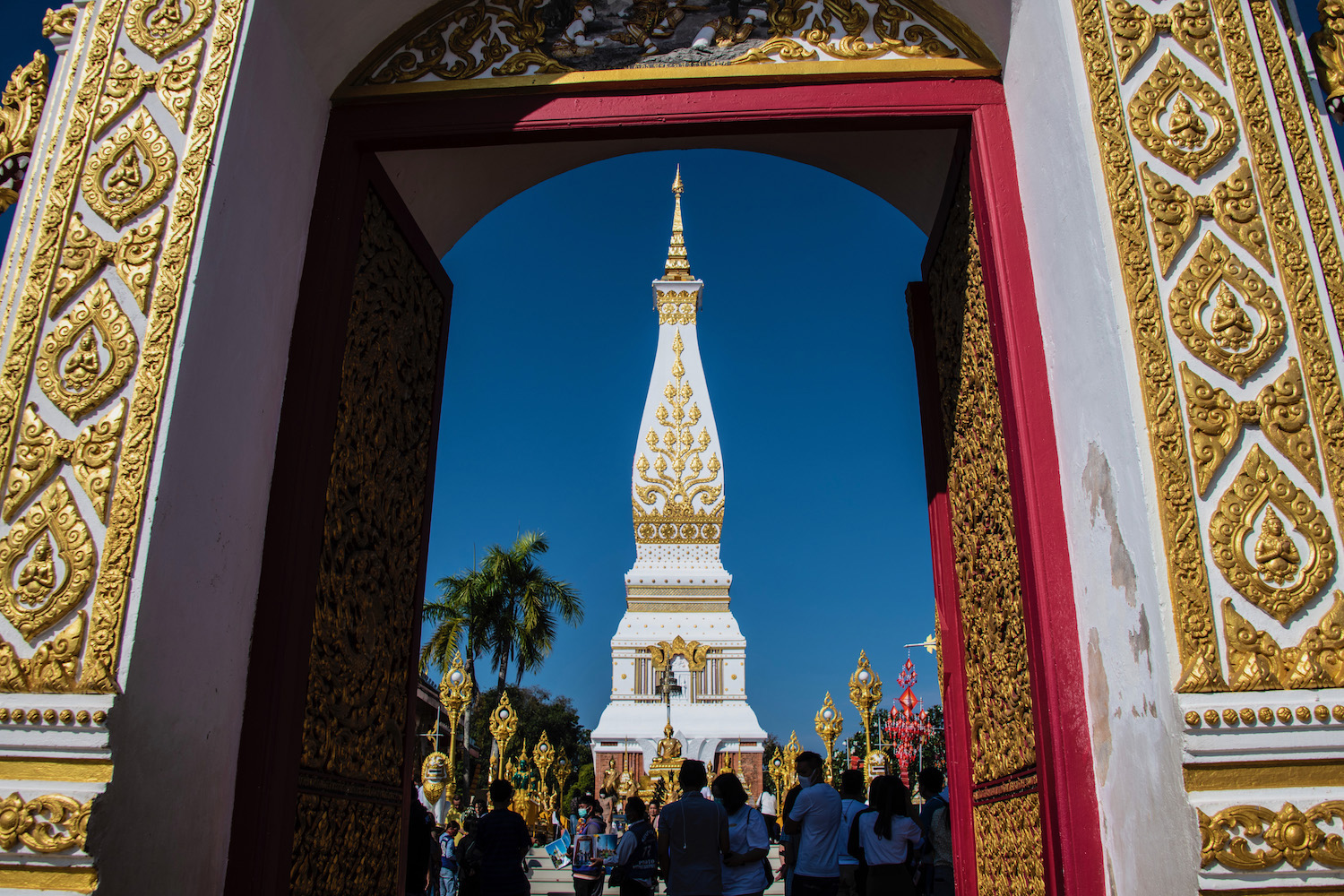
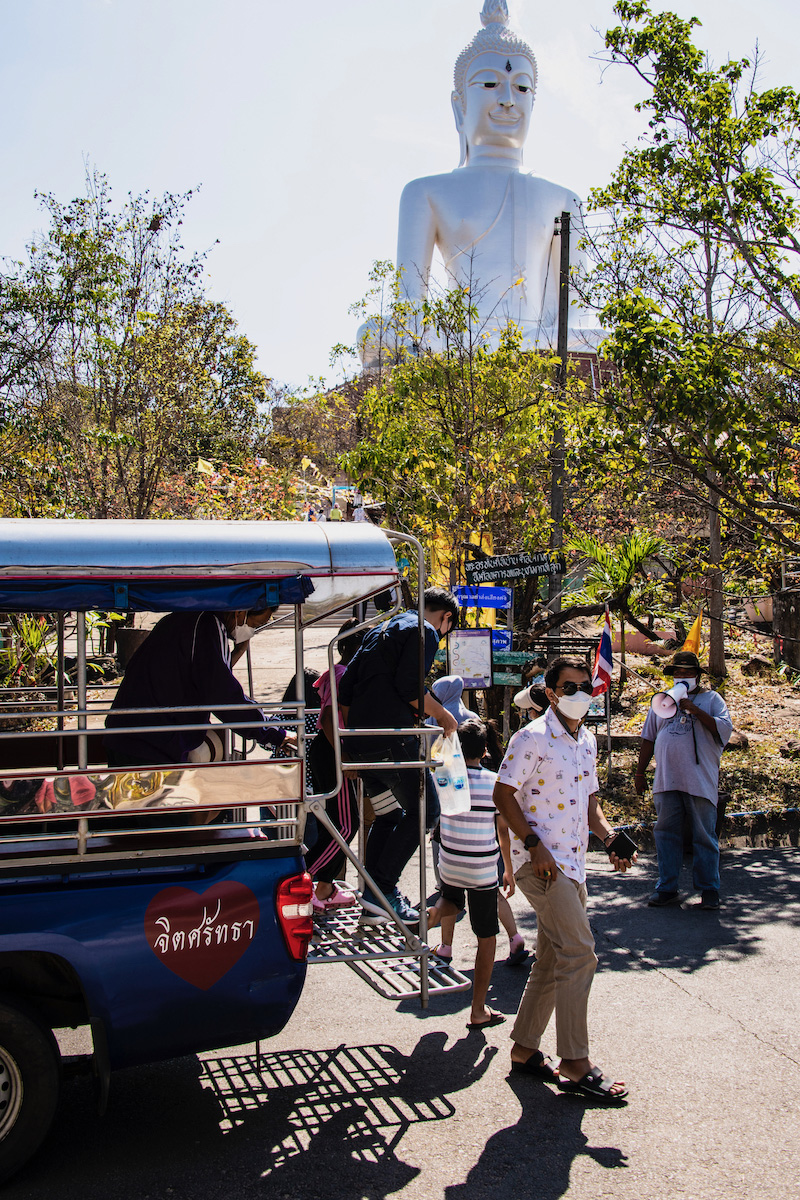
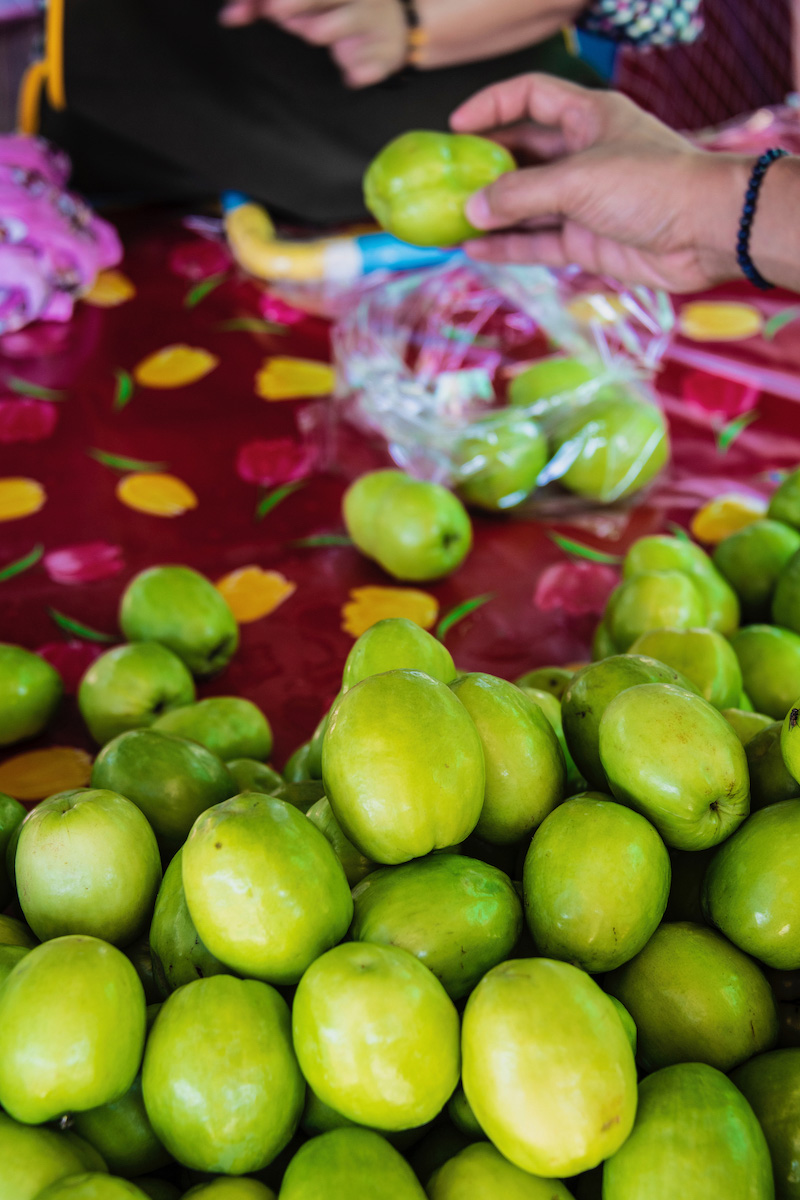
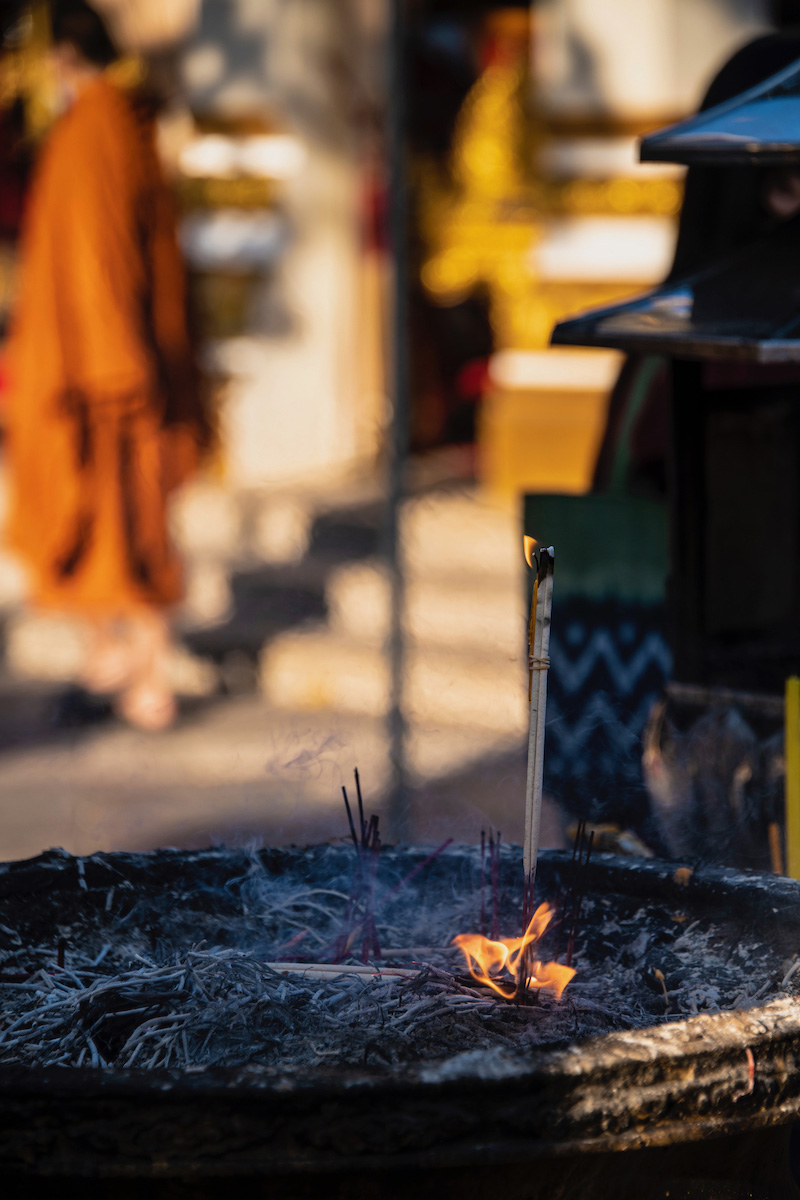
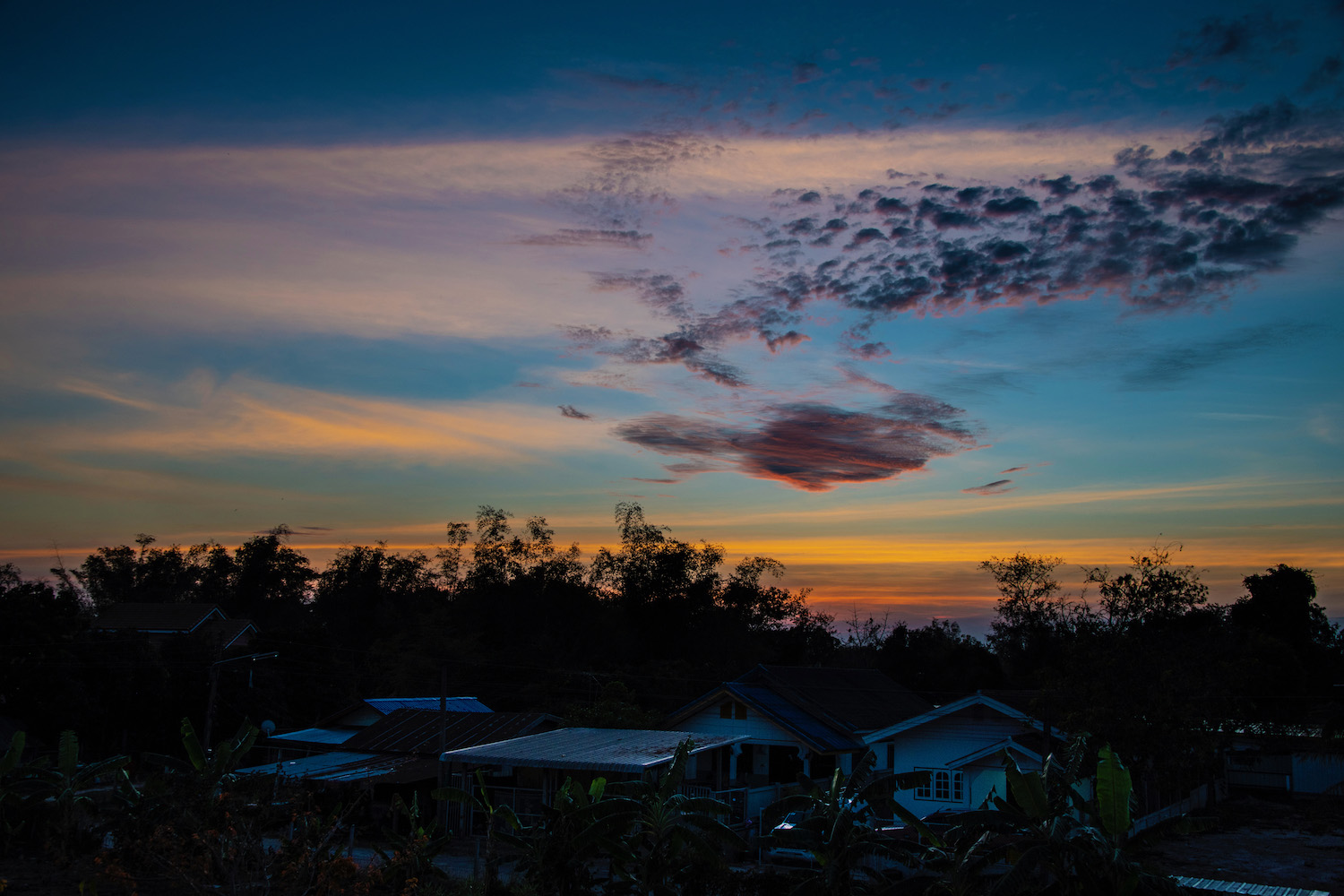
I don’t know if every cell in my body regenerated during the seven years that passed between my first and second visits to Udon Thani. Certainly, The Lion King Hotel was worse for wear than I remembered it, although I didn’t decide to stay here again with a review in mind. I figured a familiar setting—to my body, if not my mind—might help contextualize my emotions, if not my thoughts.
In reality, while I vaguely remembered the main road to whose south the hotel sits, little else about the setting was familiar. It proved an utterly blank slate for my last night in Isaan; I was as unfamiliar with its (thankfully) small footprint as Prus, who had never set foodt on the property.
As we laid in bed together, me finishing up some work and him catching up on manga, I began to think of regeneration in a different way. It’s not something that automatically happens even seven years, but a process you begin whenever you want, and with intention.
Certainly, my still-new love affair with Prus had been through many life cycles by the time our plane departed southward the next morning; it would no doubt die and be re-born a dozen or more times before we said goodbye, assuming we don’t find a way to make sure we never have to.
If Prus and I do return to Isaan together too make his final offering to Naga, whether that’s in seven months, seven years or seven decades, I doubt we’ll stay at The Lion King again. But I do hope our affection for one another is fresh and true and intentional, and that his mother still loves me, at least enough to drive us to the airport again.
Other FAQ About Visiting Isaan
What places to visit in Isaan?
Isaan is a huge destination comprising nearly two dozen provinces; it’s almost its own country. With this being said, popular places to visit include Udon Thani’s Red Lotus Sea, Khao Yai National Park near Korat and Sam Phan Bok (aka the “Grand Canyon of Thailand” near the city of Ubon Ratchathani. Various bends in the Mekong River are also key attractions in Isaan.
What is Isaan known for?
Isaan is known, among tourists, as the most “authentic” part of Thailand, but also as one with the worst infrastructure, which necessitates slow, deliberate exploration. Thai people know Isaan as the poorest part of their country, but also as the one with the best food, namely som tam papaya salad; the Isaan language and the unique culture and music of the Isaan people are also well-known among Thais.
Is Udon Thani worth visiting?
The city of Udon Thani itself is nothing to write home about; it’s not even my favorite city in Isaan, let alone Thailand. Udon Thani province, on the other hand, makes a great entry point to the Isaan region. After visiting riverside Nong Khai and the scenic Red Lotus Sea, you can head southward to Roi Et and Korat, or eastward to Nakhon Phanom.



